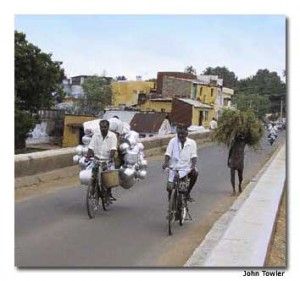
“Well this is it!” I thought. “We’re all going to be killed.”
Our bus had swerved to avoid a cow on the road, and a truck loaded with bricks was about to meet us head on. Neither driver slowed down. The road was barely wide enough for one of us, let alone two, and it was swarming with people, carts and animals. Disaster seemed inevitable.
Both drivers leaned on their horns, the masses ahead of us drifted aside and the truck whipped by with less than a hand width to spare. I breathed a sigh of relief and sank back in my seat, but before my heart rate returned to normal, we narrowly missed a collision with another bus. This was immediately followed by near misses with people, rickshaws, tractors, bicycles and even an elephant.
By now, I had figured out that this was the normal state of affairs when driving in India, and it became even clearer when I noticed that every motorized vehicle had the words, “HORN PLEASE” prominently painted on its back.
Anyone approaching anything on the road honks repeatedly and without batting an eye, or acknowledging whatever it is that is bearing down on them, the obstacles part like the Red Sea, and the traffic flashes past. Watching it was a source of endless, death-defying fascination. India’s roads are narrow, pot holed and congested with a bewildering assortment of buses, trucks, cars, tuk tuk mini buses, bicycles, cows, bulls, goats, sheep, chickens, dogs, carts, dromedaries, pigs and yes, the occasional elephant. These are the normal obstacles.
No sooner had I become used to them, when we encountered new ones, and I watched in amazement as our driver swerved to avoid people sleeping in the middle of the road, vehicles being repaired wherever they happened to grind to a halt and the odd bit of road repair.
Preventative maintenance seems to be unknown in India. People change tires and transmissions, repair engines and brakes and the like wherever they happen to stop. Sometimes they put a few boulders around whatever they are working on to form a sort of moveable guardrail. There are very few garages for repairs, and the roads are lined with dusty shops repairing tires and all things vehicular.
None have signs but are identified by the columns of used and shredded tires, or the mounds of engines and parts on the side of the road. It seems customary to fling bicycle tires onto the roofs of the bicycle shops, and inner tube repair places are recognized by the garlands of tubes hanging limply from nearby trees.
Road construction is an example of India in microcosm. When the potholes become large enough to do really serious damage, they are repaired. I suspect that this means that someone or something has fallen in and cannot get out. Nevertheless, the process is amazing. The road repairs are organized and paid for by the Indian Roads Department.
Yet, whole families are involved, as women doing hard physical work and child labor are common and apparently normal sights in India. First a load of granite boulders is dumped on the road near the holes. Women armed with heavy sledge hammers attack this, breaking it into fist sized chunks.
These are passed on to children who pound them with smaller sledges until it is reduced to gavel. Another group of women load the gravel by hand into buckets, place these on their heads and take them to the potholes. In the meantime, a fire has been started in the ditch and 50-gallon (190 liters) drums of tar have been put on to melt. Some time later, the tar is poured over the gravel and men wearing open sandals more or less smooth it over, and the repair is “complete.”
The strangest thing about all of this is that in four weeks we saw only one accident and hardly any vehicles that had dents or scratches.
Driving in India is certainly not for the fainthearted. It is a cacophony of honking combined with heat, dust and unimaginable crowds. Perhaps the Indians have the right, if somewhat fatalistic, approach to the whole mess. I noticed that the red stoplights in Delhi do not say, “Stop.” Instead they flash the word, “Relax.” Being driven here is one thing. Driving oneself would be shear madness.
IF YOU GO
We spent four weeks crisscrossing the Indian subcontinent from Chennai to Cochin, Madurai, Mysore, Bangalore, Jaipur, Mumbai, Agra, Varnasi and Delhi. All in all, we traveled more than 3,000 miles (or about 5,000 km) by train, plane, boat and bus. Although we are experienced independent travelers, we decided to take a tour and let someone else handle the transportation, tickets, guides and hotels. This made it mindlessly easy and luckily, our 15 companions were compatible.
A tour ensures that you will see things you would not be able to discover on your own and the guide handles any problems and there were lots of them. However, you can do it on your own and at less cost. Read up on India, know where you are going, what you want to see, pre-book your accommodations, and hire a car and driver. It generally costs about US$30 per day for the car and the driver. But be very sure that they really do speak your language.
Official Website of the Ministry of Tourism:
www.tourisminindia.com
- How to Renew a US Passport Quickly and Affordably - April 19, 2024
- 6 Reasons to Visit Portland, Maine (+ Travel Tips) - April 18, 2024
- Cruising with Discovery Princess on the Mexican Riviera - March 30, 2024
